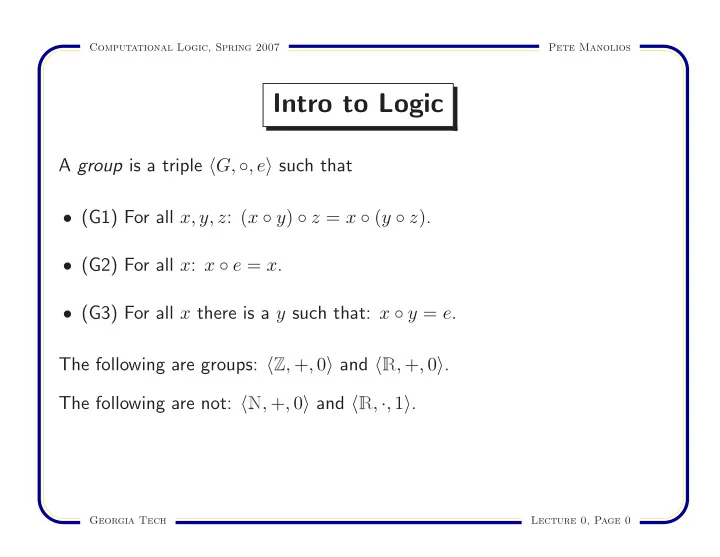

Computational Logic, Spring 2007 Pete Manolios Intro to Logic The following are groups: � Z , + , 0 � and � R , + , 0 � . The following are not: � N , + , 0 � and � R , · , 1 � . A group is a triple � G, ◦ , e � such that • (G1) For all x, y, z : ( x ◦ y ) ◦ z = x ◦ ( y ◦ z ) . • (G2) For all x : x ◦ e = x . • (G3) For all x there is a y such that: x ◦ y = e . Georgia Tech Lecture 0, Page 0
Computational Logic, Spring 2007 Pete Manolios The axioms mention right inverses; below we claim that left inverses exist. Theorem 1 For every x , there is a y such that: y ◦ x = e . In mathematics, we study the properties of various objects, e.g. , groups. The properties that these objects enjoy are captured with “non-logical” axioms, e.g. , in the case of group theory, (G1)-(G3). The theory of groups consists of all theorems that are derivable from the “non-logical axioms” via logical reasoning alone . This reasoning cannot appeal to intuition or “obvious truths” about groups. So, what exactly is a “proof”, then? This question naturally leads to computer science and historically that is what happened, as a proof has to be machine-checkable. Georgia Tech Lecture 0, Page 1
Computational Logic, Spring 2007 Pete Manolios Proofs and Logic When we prove theorems about groups, then the results apply to every instance of a group, a structure satisfying G = { ( G 1) , ( G 2) , ( G 3) } . If some formula ϕ holds in every group (denoted G | = ϕ ), then does there necessarily exist a proof (denoted G ⊢ ϕ )? Note that proofs are finite, but there are many groups; how many? Some of the results we prove will answer these questions in a very general way. Preview: There are so many groups, that they do not even form a set. Also, we will present a simple proof theory. Then, we will see that for any set of sentences Φ and any sentence ϕ , Φ | = ϕ iff Φ ⊢ ϕ . This is G¨ odel’s completeness theorem, perhaps the most important result in logic, as it relates syntax with semantics. Georgia Tech Lecture 0, Page 2
Computational Logic, Spring 2007 Pete Manolios Alphabets An alphabet A is a nonempty set of symbols . A ∗ is the set of finite strings over A . Lemma 1 If |A| ≤ ω then |A ∗ | = ω Georgia Tech Lecture 0, Page 3
Recommend
More recommend